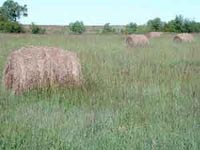Resource Library
Plant of the Week: Big Bluestem
The University of Arkansas System Division of Agriculture does not promote, support or recommend plants featured in "Plant of the Week." Please consult your local Extension office for plants suitable for your region.
Plant of the Week
Big Bluestem
Latin: Andropogon gerardi

For any who have written a weekly column, choosing the topic is oftentimes as hard as the actual writing. But not so this week. After a wonderfully rewarding autumnal tour of the prairie, all I can think of is grass, especially the dominant grass of the tallgrass prairie - big bluestem.
Big bluestem, Andropogon gerardi, is an impressive native grass found wild in every state and Canadian provenance east of the Rockies. But nowhere is it more grand than in the southern Great Plains of northeastern Oklahoma and southwestern Kansas.
In Arkansas, the tallgrass prairie extends into our western counties where remnants of it remain in Benton and Sebastian counties. The "tall" in tallgrass prairie comes primarily from native grasses such as big bluestem, Indiangrass and switchgrass.
Big bluestem is a clump-forming perennial grass reaching heights of 8 feet or more when it flowers in the fall. These stout flowering stems are topped by an inverted turkey-foot type inflorescence that makes big bluestem easy to differentiate from the kindred grasses of the prairie.
During the summertime, big bluestem clumps often produce glaucous, blue-green leaves. In the summer, the tallgrass prairie is a rich, verdant green that soothes the eye and soul. But, come fall, the grasslands transform into a waving sea of reddish-beige that -- at least to my eye -- is as beautiful as the best fall foliage display of the eastern woodlands.
The Great Plains doesn’t often come to mind when one thinks of scenic wonder, but they should. Agriculture has transformed much of the plains into the breadbasket of the nation, but large stretches of tallgrass prairie still remain in rocky areas of the Flint Hills region of east-central Kansas and adjacent areas in Oklahoma.
The southern boundary of this rocky ground protrudes into Osage County,
Oklahoma north of the county seat of Pawhuska. A friend, a lifetime resident of Osage County, told me that the Osage chiefs selected the rockiest ground for their reservation because they knew the white man’s plow would never hold sway against the rocky soil.
It is in this area that the Nature Conservancy purchased its 38,000-acre Tallgrass Prairie Preserve in 1989 where it is restoring the ecosystem to its former grandeur.
The tools the Nature Conservancy biologists will use to restore the ecological integrity to the prairie are decidedly low-tech: fire and buffalo. Prescribed burns are conducted at different times of the year to control encroachment of woody vegetation and to help in maintaining a complementary mix of wildflowers in the stand of grass. The buffalo herd, originally introduced as 300 head in 1993, now stands at 1,500 animals. The herd will top out at 3,300, including a spring crop of 1,100 calves.
The buffalo herd that used to ply the Great Plains is estimated to have numbered over 12 million head but was reduced to fewer than 1,000 animals by the close of the 19th century.
The Nature Conservancy just celebrated its 50th anniversary. This organization uses the marketplace, coupled with the love private landowners have for important ecological areas, to preserve valuable wild places. The Conservancy raises funds from private sources to buy valuable pieces of property, creating a win-win situation for both the landowner and the environment.
Big bluestem is easily grown in any sunny, reasonably fertile soil. It is best used in mass plantings and natural areas at the back of the border where it is right at home in a naturalistic landscape. Once established, plants can be easily divided in the spring to increase the area devoted to the stand of native grass.
By: Gerald Klingaman, retired
Extension Horticulturist - Ornamentals
Extension News - November 22, 2002
The University of Arkansas System Division of Agriculture does not maintain lists of retail outlets where these plants can be purchased. Please check your local nursery or other retail outlets to ask about the availability of these plants for your growing area.